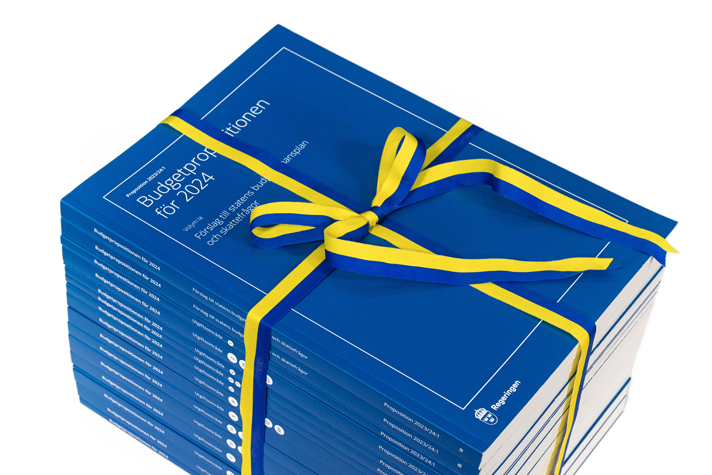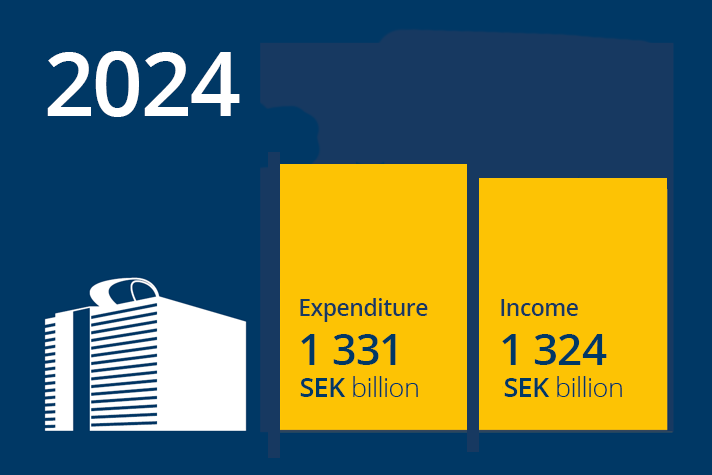The Budget for 2024 in five minutes
Published
Sweden is in an economic winter. Inflation and high interest rates are putting pressure on both households and businesses. At the same time, the security environment has deteriorated. In a difficult economic situation, the Government is prioritising combating inflation, assisting households and the welfare system, and strengthening the judicial system and defence. Against this background, the Government presents its Budget Bill for 2024 with reforms totalling SEK 39 billion next year.

The Budget Bill contains the Government’s proposals for the central government budget for next year. On this page, you can read more about:
- The Government’s assessment of the economic situation and public finances
- The reforms in the budget to make Sweden strong
- The role of fiscal policy in combating inflation
- Central government expenditure and estimated revenue for 2024
The Government’s assessment of the economic situation and public finances
High inflation continues to impact the Swedish economy, which is expected to be in recession in 2023 and 2024. High inflation and higher interest rates combined with waning international demand are the primary reasons for the flagging economy. Although there are some bright spots with a lower rate of inflation, core inflation remains high. This puts a heavy burden on households and businesses. Due to the recession, unemployment is expected to rise in 2023 and 2024. In 2025, the economy is expected to rebound, which will result in increased demand for labour.
The budget for 2024 reflects the economic situation, and priorities must be set so as to avoid the risk of stoking inflation. At the same time, households and the welfare system will obviously need assistance in this difficult situation.
Key macroeconomic indicators
| 2022 | 2023 | 2024 | 2025 | 2026 | |
|---|---|---|---|---|---|
| GDP1 | 2.8 | -0.8 | 1.0 | 2.9 | 3.1 |
| Unemployment, % of labour force aged 15-742 | 7.5 | 7.6 | 8.2 | 8.3 | 7.4 |
| CPIF3 | 7.7 | 6.0 | 2.7 | 2.0 | 2.0 |
| General government net lending, % of GDP | 0.8 | -0.2 | -0.7 | -0.4 | 0.6 |
| General government gross debt, % of GDP | 32.9 | 30.3 | 30.2 | 29.8 | 28.6 |
1 Fixed prices.
2 Per cent of labour force.
3 Consumer price index with fixed interest rate.
Note: Based on published statistics up to and including 07/08/2023 and 10/08/2023 respectively for general government net lending and general government debt.
Sources: Statistics Sweden and own calculations.
Complete table of key forecast figures
Reforms in the budget to make Sweden strong
The Budget Bill for 2024 aims to combat inflation and manage its effects, not least for households and the welfare system, and to strengthen the judicial system and defence. In light of the difficult economic situation, the Government needs to focus first and foremost on addressing Sweden’s most acute problems.
The Government’s work is based on a three-part long-term plan to get Sweden through the difficult economic situation.
- Combat inflation and assist households and the welfare system
- Re-institute the work-first principle
- Implement structural reforms to stimulate growth
Below you will find the budget statement and the table of reforms that presents the Government’s investments in figures.
The role of fiscal policy in combating inflation
The Government is taking responsibility for the difficult economic situation that Sweden is in by continuing to pursue a restrained fiscal policy in order to drive down inflation. Inflation needs to return to a low and steady level.
Inflation has fallen this year, but remains high. Core inflation, i.e. inflation adjusted for energy and food prices, has proved slow to change.
Forecasts predict that inflation will continue to fall in 2024, but the inflation target of two per cent will not be reached until 2025. If inflationary pressure proves to be higher than expected, an expansive fiscal policy would run the risk of the high inflation lasting even longer, with negative consequences for all of society. Fiscal policy must therefore remain restrained until the outcome clearly shows that inflation is approaching the inflation target.
Central government expenditure and estimated revenue for 2024

Central government expenditure totalling SEK 1 331 billion is proposed for 2024. Central government income is expected to amount to SEK 1 324 billion in 2024. Central government finances are therefore expected to show a deficit of approximately SEK 7 billion in 2024.
Next step – the Riksdag processes the draft budget
When the Government has presented the Budget Bill, the Riksdag’s processing begins. It considers the draft budget in two different steps:
Step 1: First, the Riksdag adopts the guidelines for economic policy and the economic framework of the central government budget. The decision on the economic framework – known as expenditure frameworks – guides the continued processing in the Riksdag, as the expenditure frameworks cannot be exceeded. This decision is usually referred to as the framework decision.
Step 2: In the second step, the Riksdag decides how to divide up expenditure in each individual expenditure area, in other words, how much money different activities will receive. Processing of the Budget Bill is complete once the Riksdag has decided on the proposals for all expenditure areas. The Riksdag then finalises the central government budget.
Central government budget
More about the central government budget.

 X
X